Active Transport Lessons from Taipei for Australia
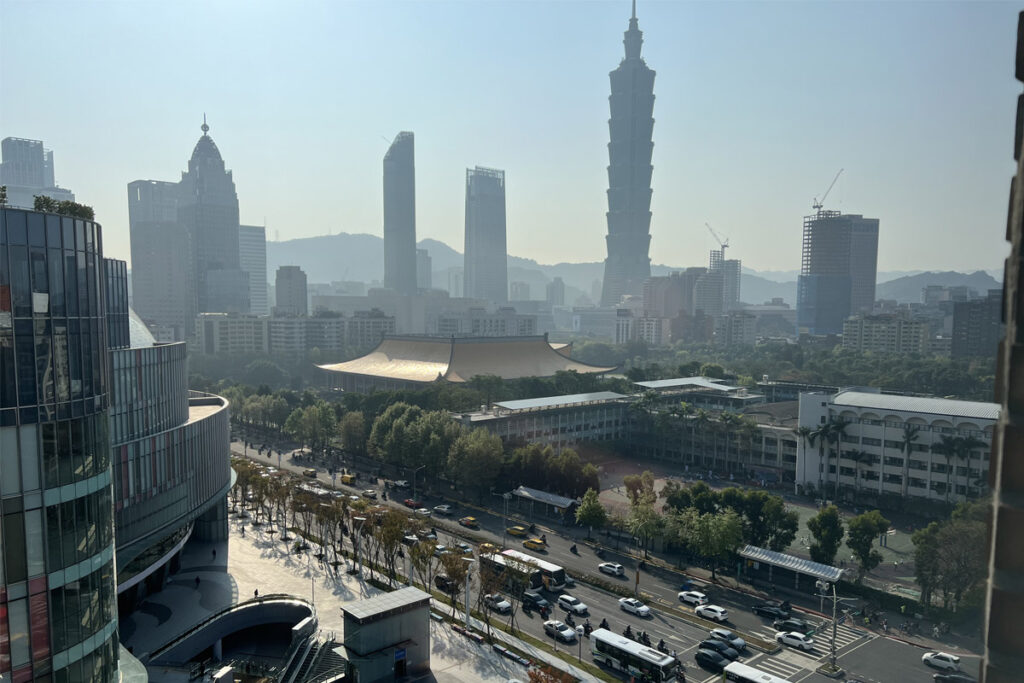
Taipei, Taiwan
When it comes to transportation and urban design, every large city faces a similar set of challenges and trade-offs, but they respond to these in vastly different ways.
Taipei is the capital and by far the largest city of Taiwan. I first visited in 1996 to attend the annual Taipei Cycle expo, which is arguably the second largest and influential trade show in the world after Eurobike.
From then until 2017 I attended just about every year. But then, firstly due to the sale of our former Bicycling Trade magazine, followed by covid, 2024 was my first year back to Taipei.
Over the first two decades of attending each year, I had seen massive changes to the city, so I was looking forward to seeing what further progress Taipei might have made after my seven year absence.
A Long Way from Kansas
Any visitor from Australia will immediately recognise that Taipei different to anything they’re used to back home, as Dorothy famously remarked in the Wizard of Oz.
Taipei City itself has a population of 2.5 million, but the greater urban area is home to 7.05 million.
The city core is built on a pancake flat floodplain, dissected by large rivers which are capable of massive floods. To protect the city from potential catastrophe, they’ve built high concrete levy barricades along every riverbank. The downside of this is a visual and accessibility disconnect between the wide open spaces of the rivers and the densely packed city.
For the first few years that I visited the show, I wasn’t even aware that the city was closely surrounded by steep hills and mountains. That was because the air was so polluted that I couldn’t see them! These days both the air and the city in general, is much cleaner.
Flat land is scarce, not just in Taipei city, but the entire country, which has a total population of 23.5 million, but an area similar to Tasmania. Most of Taiwan is mountainous wilderness. Most residents live in high density cities and even the ‘countryside’ looks nothing like Australia’s.
The 2.5 million Taipei City residents are living in a density of 9,242 people per square kilometre. By comparison, Australia’s most densely populated city, Sydney, has 428 people per square kilometre across its greater urban area – 21 times more spread out, although some of Sydney’s densest inner city suburbs are equal or greater than the overall average of Taipei City.
Density of course has a significant influence on transport modes which we’ll now look at more closely.
Bicycles, E-Bikes and Scooters
When I first visited Taipei, there was hardly a bicycle to be seen outside the confines of the trade show. The only people you’d see on bicycles were a few poorer workers commuting or perhaps delivery riders wearing traditional Chinese straw hats and riding on heavy old tricycles.
Typical bike factory owners and their staff wouldn’t be seen dead riding a bike – this was an industry built around exports to those weird westerners, while the transport of choice for a Taiwanese bicycle factory owner was a large, black Mercedes, the bigger and newer the better!
King Liu, founder of Giant Bicycles, famously was a catalyst to change the entire industry’s and nation’s attitude to cycling, initially by riding almost 1,000 km around the island for the first time when he was already well into his 70’s.
Forest Gump style, this became an annual event with an ever growing group joining him, including many of those key bicycle industry leaders, who swapped their Mercedes for a Taiwanese made bicycle.
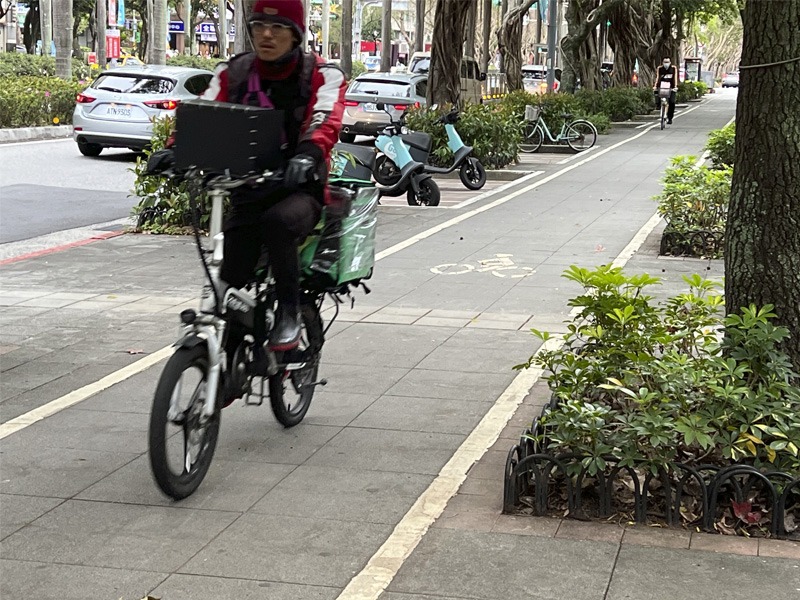
King, who was a highly respected and prominent business pioneer in Taiwan, was appointed by the President of Taiwan as his special advisor on bicycles and oversaw a transformation of the country and culture, from one where no middle class citizen would be seen dead on a bike, to one today with extensive bicycle paths and people from every age, gender and income happy to ride.
Most of the cyclists I saw were on budget priced utilitarian bicycles. Only a few were on e-bikes which are mainly 20 inch wheel domestic brands. There are hardly any privately owned e-scooters on the paths in Taipei and there is no shared scooter scheme.
Bikeshare is extremely popular in Taipei. The system, called You Bike had already been running for several years before I stopped visiting Taiwan in 2017 and was an immediate success. Since then, the bikes have been upgraded, with some more electronic ‘smarts’ for hiring them built into every bike. But surprisingly, I saw no e-bikes in the fleet. You Bike has recently developed an e-bike version, but I’m not sure about its current deployment status.
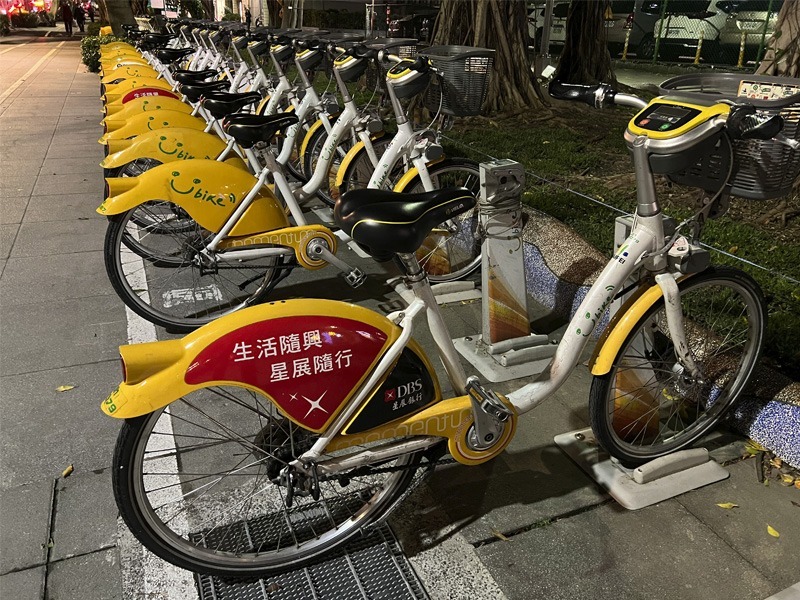
I spoke to a representative of a smaller bike share competitor, that so far has fleets in two Taiwanese cities. He said that 30% of their fleet are e-bikes and future city tenders are requesting 50% of the fleet to be e-bikes. Like everywhere else in the world has found, he said that the e-bikes are ridden more often, even though the hourly fee is higher.
Unlike the expensive Australian bike and scooter share schemes, the You Bikes in Taipei are extremely cheap to hire: NT$10 (A50 cents) per 30 mins for the first 4 hours, NT$20 (A$1) per 30 min for 4-8 hours and NT$40 (A$2) per 30 min for over 8 hours, with further discounts for long term passes.
Unfortunately, the payment system is not fully integrated with the general public transport payment system. I was having trouble getting the app to work and in particular, to accept my international credit card details, so I went to the nearby MRT (metro) station and was advised that there was a U-Bike information booth two stations away.
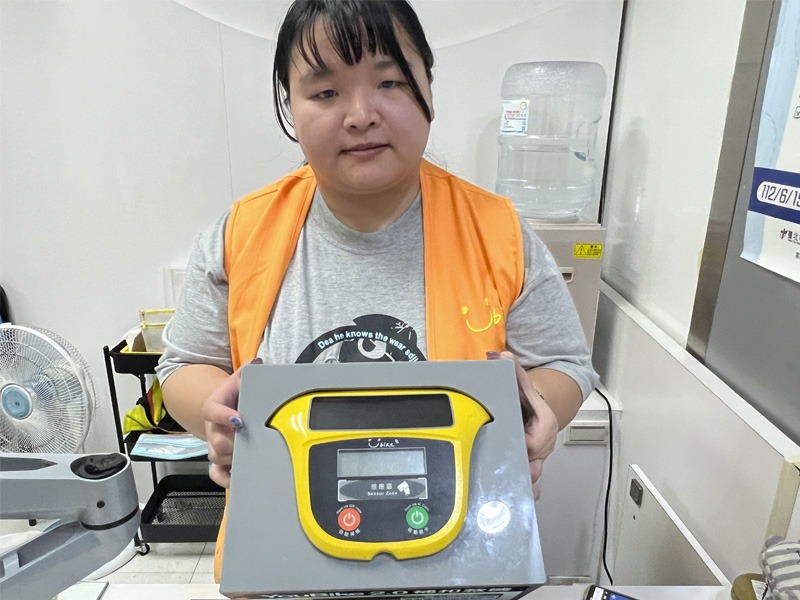
There a very helpful representative got me set up and showed me how to make best use of the app. Back up on the street, I electronically unlocked a bike via the app and rode across town. The bikes have three speed hub gears and the seat height adjusts via a large spring-loaded lever. Even at full height, it was a bit too short for me (at 182cm tall), but fine for general riding around town. No helmets are required for cyclists in Taiwan and none are supplied on any of the hire bikes – at least all of the ones that I saw.
According to bikesharemap.com Taipei has the seventh largest bike share system in the world with 27,870 bikes and 63,149 docks spread across 2,597 docking stations. Bikes have to be docked at the end of a ride – there’s no ‘floating’ option, unlike the Australian schemes.
The enemy of a useful docked bike share system is either completely full or completely empty docking stations. On one occasion when I looked at the live data, only 40 were completely full and 46 were completely empty In total just over 3% of all 2,597 docking stations.
During my most recent visit I took at least half a dozen rides, both during the day and at night, mainly in the city centre.
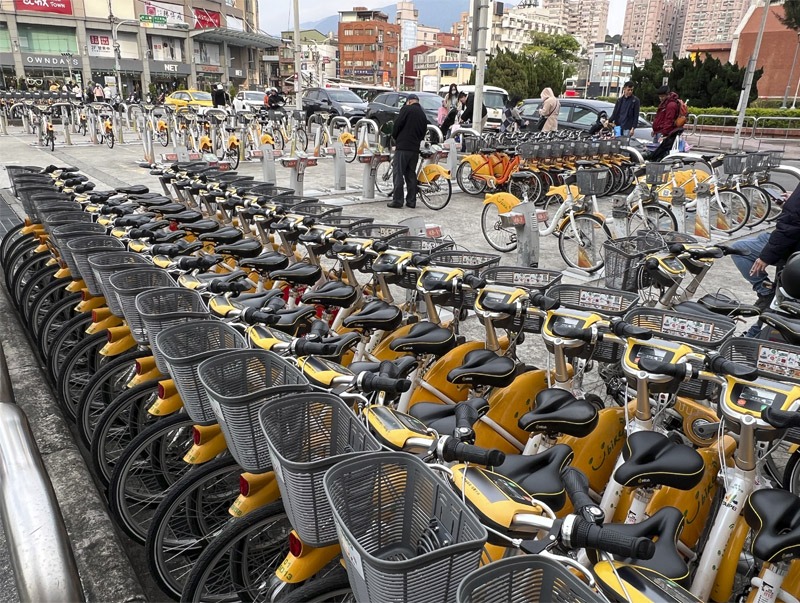
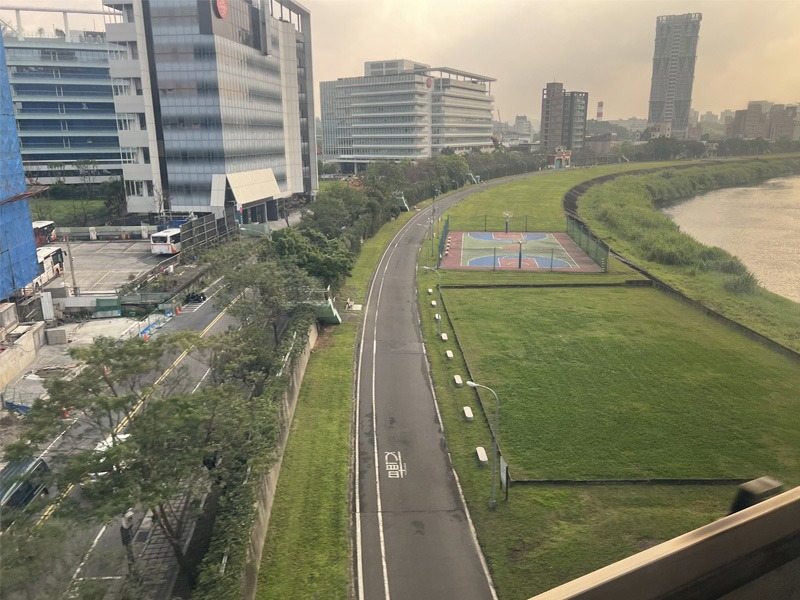
If I’d had more time, I could have ridden along the extensive riverside bike path network as I’d done in past years. Thanks to those high levee walls that I previously mentioned, the riversides are surprisingly peaceful and make for pleasant riding. But this trip I did a ride in one tourist area out of the city, where many other people were also using You Bikes on a coastal cycle path.
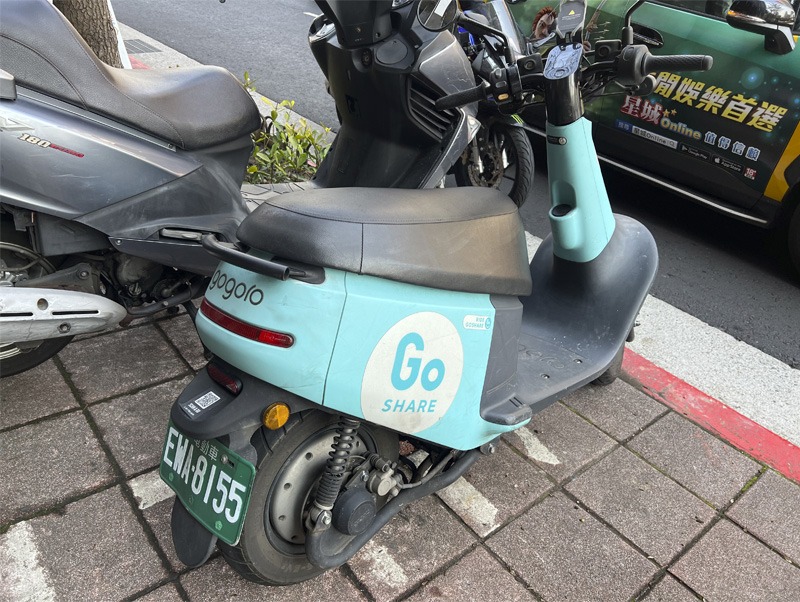
Mopeds
Like most Asian cities, Taipei is home to a gazillion motor scooters, which I’ll refer to as mopeds from now on in this article. The sound of literally a hundred or more two stroke motor scooters taking off full throttle from a green traffic light on any of Taipeis main intersections is like a noisy swarm of angry bees. This was one of my lasting impressions of Taiwan from previous visits.
I was looking forward to seeing the Gogoro electric mopeds and their fast-swap battery stations that we’ve previously written about here and here. This is a Taiwanese publicly listed company that has recently expanded to India and other countries.
Unfortunately, the bee swarm was as noisy as ever. There are definitely a lot of Gogoro’s and a few other brands of e-mopeds on the streets, but it takes a long time to convert an entire fleet where many scooters look to be used for a decade or more.
My rough survey over four days of close observation would suggest that the total fleet share for e-mopeds is still only about 5%. The e-mopeds can accelerate and keep up with the swarm, but they tended to be ridden by more cautious female riders who were further back in each traffic light ‘Grand Prix’. The young lads still prefer the fastest, noisiest, souped up moped they can create – these guys are often surging through amber traffic lights at 80 kph or more. This led me to check Taiwan’s road fatality rate – about 12 per 100,000 per year, which is almost double Australia’s, and about six times ‘best practice’ countries, but comparable with the USA’s. One report said that 64% of all traffic deaths in Taiwan in the first six months of 2023 involved mopeds.
I was told by a market expert that the Gogoro’s retail for about 25% more than the petrol mopeds. If that’s the case and the Taiwan government really wanted to electrify the fleet faster, it wouldn’t be too expensive to provide sufficient subsidies to tip the scales.
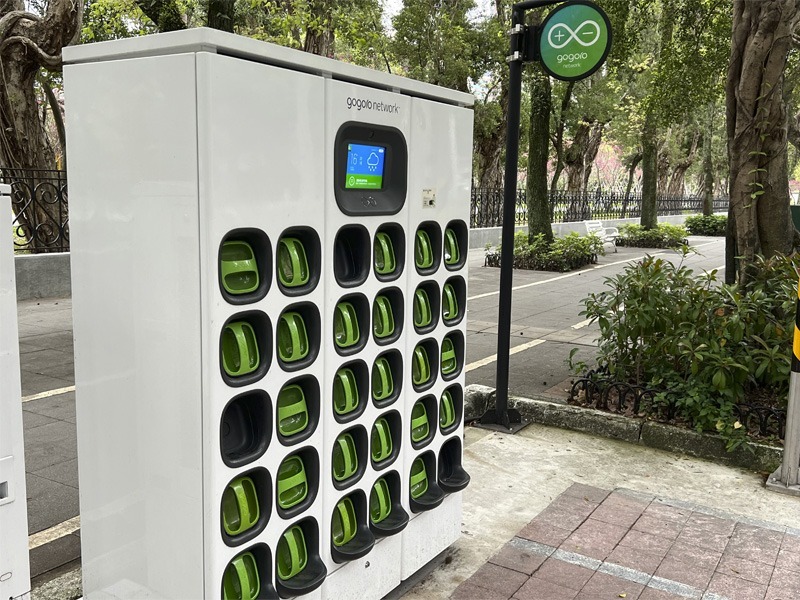
Gogoro has open sourced their battery system so that other brands can make and sell mopeds that use the same batteries and can use the Gogoro battery swap stations. But the traditional petrol moped brands have been reluctant to change so far. One report I read said that Gogoro had 75% market share of e-moped sales.
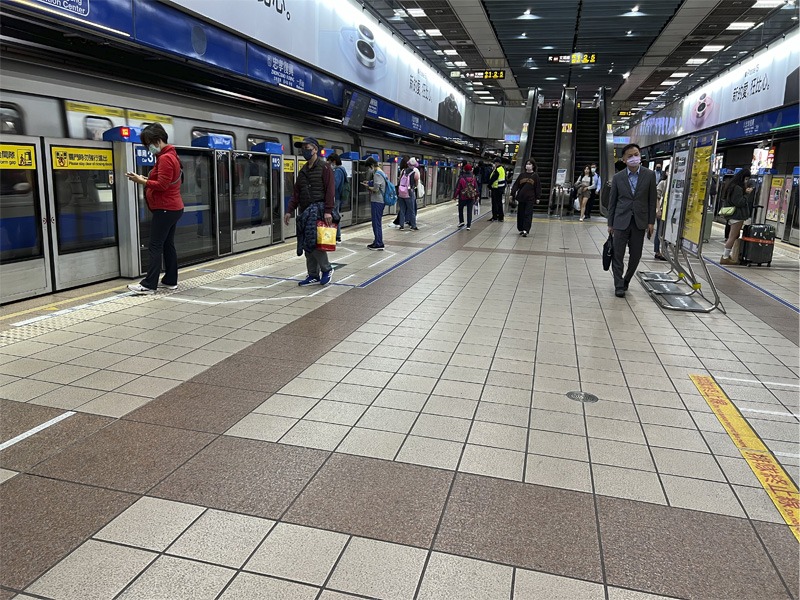
Metro Rail – “MRT”
Taiwan’s government equivocated for decades before finally building a metro system. During that time the number of cars registered in Taipei grew from 150,000 to one million and the roads became completely choked with traffic, not to mention air pollution.
When I first visited Taipei, from memory there was only one small overhead metro line, now known as the Brown Line. There was huge disruption for years as they built the underground metro system which is mainly a shallow “cut and cover” system, running directly under the city streets, New York style, not like London’s deep underground ‘Tube’ system.
Today there is an extensive, clean, modern metro network with 146 km of lines and 117 stations, all known as the MRT (mass rapid transit). In total the MRT carries 710 million passengers per year (in 2023) or just under two million per day. It certainly feels like that when you’re riding it!
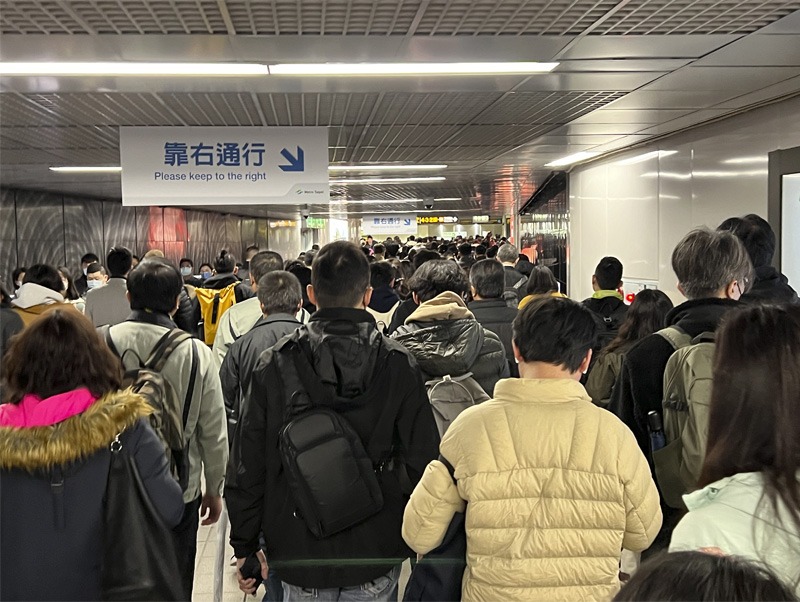
The trains are frequent, fast and cheap to ride. For a single ride from the inner stations, the fare is just NT$20 (A$1) and even the outermost stations only increase to NT$45 (A$2.50). You can buy a day pass with unlimited rides for NT$150 (A$7.50)
Bikes are allowed on the MRT during off peak hours only. Even the most ardent bicycle advocate would agree that this restriction is a good idea. During peak hours some MRT trains and stations are so crowded that you might have to queue up within in the marked lines on each platform and miss two or three trains before you can squeeze on board. This is not as bad as it sounds because the trains run about every three minutes during peak times and video screens count down the time until the next train arrives in five second increments.
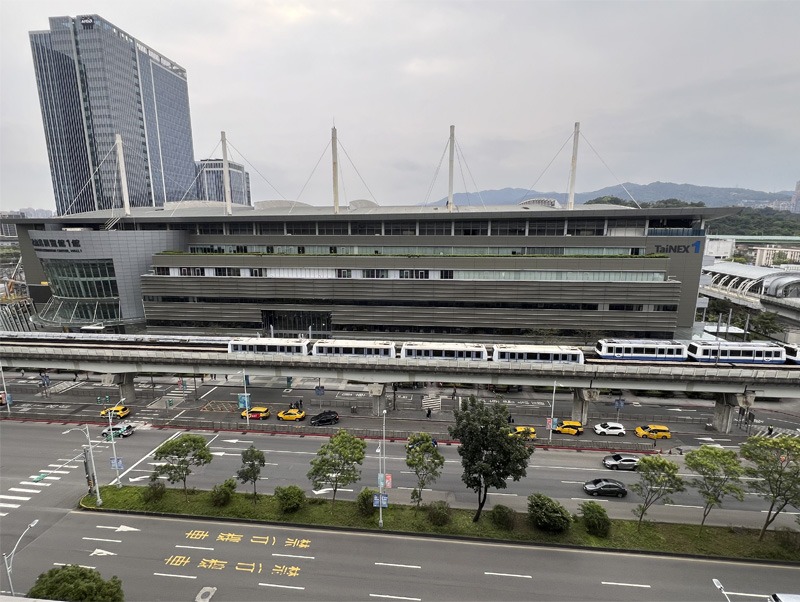
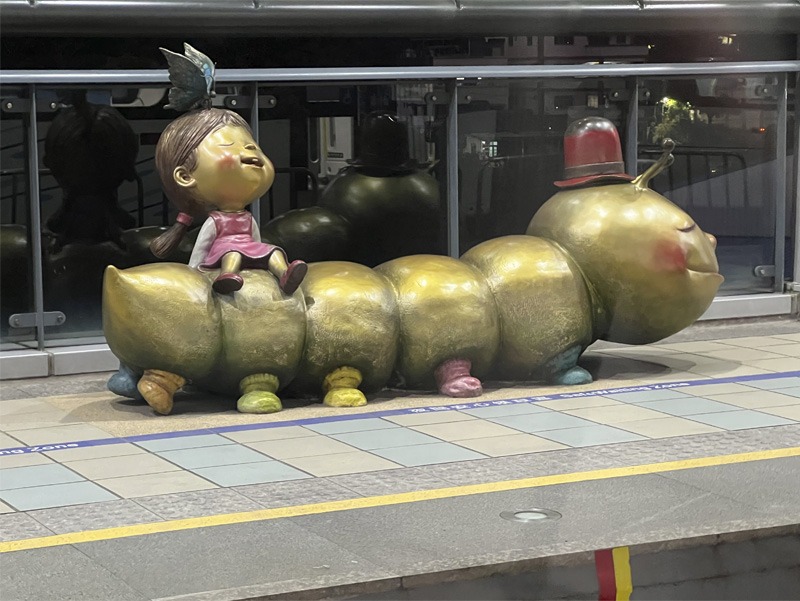
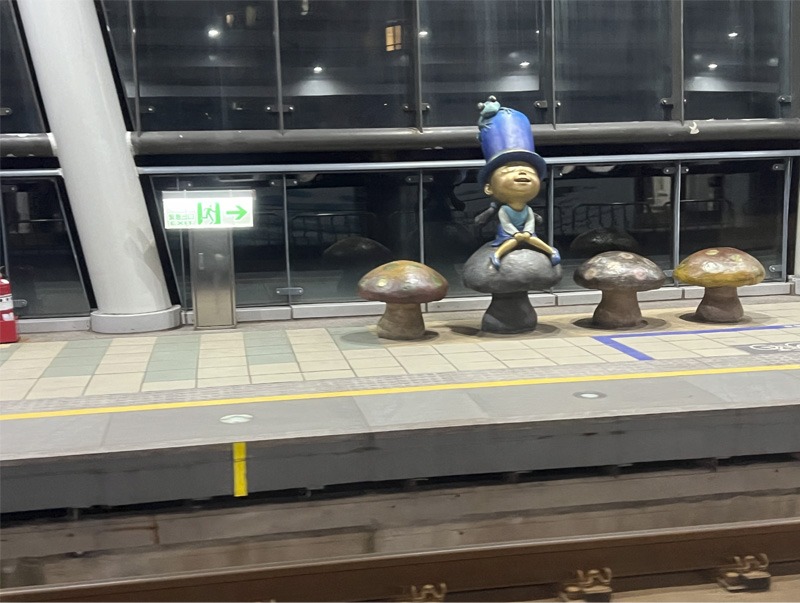
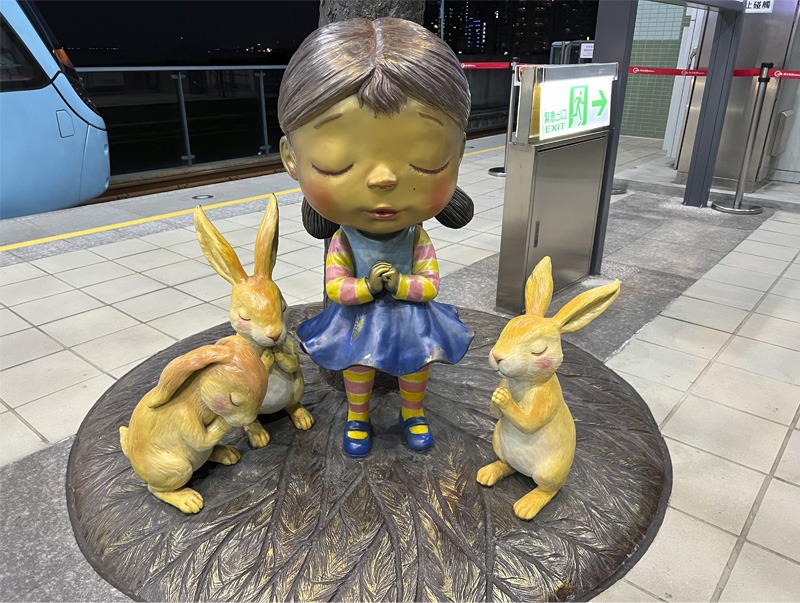
The MRT network also connects with a light rail that I rode and even a gondola that I’ve ridden on a previous visit. There’s also an extensive intercity rail network and a 300 kph high speed intercity rail service, that I’ve also ridden previously, which is quiet, spotlessly clean and frequent. This service carried almost 82 million passengers in 2023.
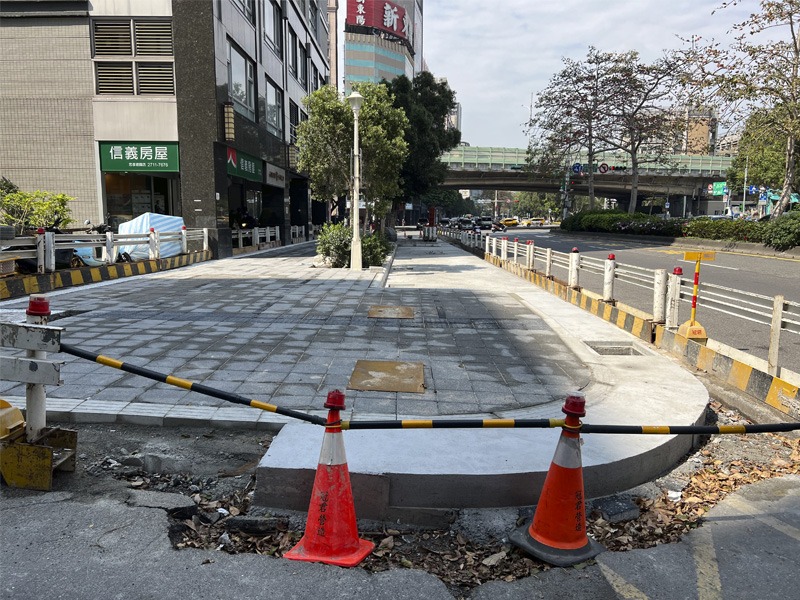
Walking and Footpaths
Typical shopping streets have building with walkways under the front section – ie not verandas but under crofts. Then in the case of wider streets, there will also be an outside footpath, then a bike path, then the kerb and gutter then the motor vehicle section.
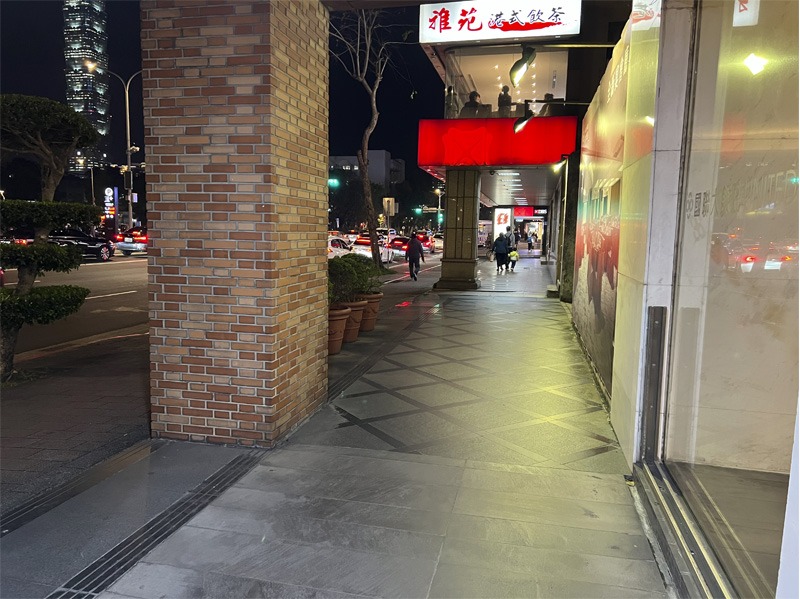
Taipei also has many narrow laneways which often have no footpath at all. Some of these are now adding green pedestrian lanes, which are not kerb protected and cars are not physically barred from. It’s certainly squeezy and not entirely comfortable to walk on, but at least the speed limit on these local streets is 30 kph.
Over the past 28 years since I first visited, I’ve seen significant improvements in the quality of footpaths, and also kerb ramps for those in wheelchairs, but there are still many more improvements that could be made.
Buses
There’s a bewildering array of multi-coloured buses operating along the main roads. Taipei has no less than 15 private bus companies, but for several decades now they’ve been coordinated by a central government authority. The buses are even cheaper than the MRT at $NT15 (A$0.75) per one way ride.
Of the hundreds of buses that I saw and heard, not one was electric. This is in stark contrast to mainland China where virtually the entire bus fleet was electrified years ago.
Most of the buses look quite old, and certainly of old styles. Perhaps all of this relates to the private system operators lacking the cash or incentive to modernise and electrify.
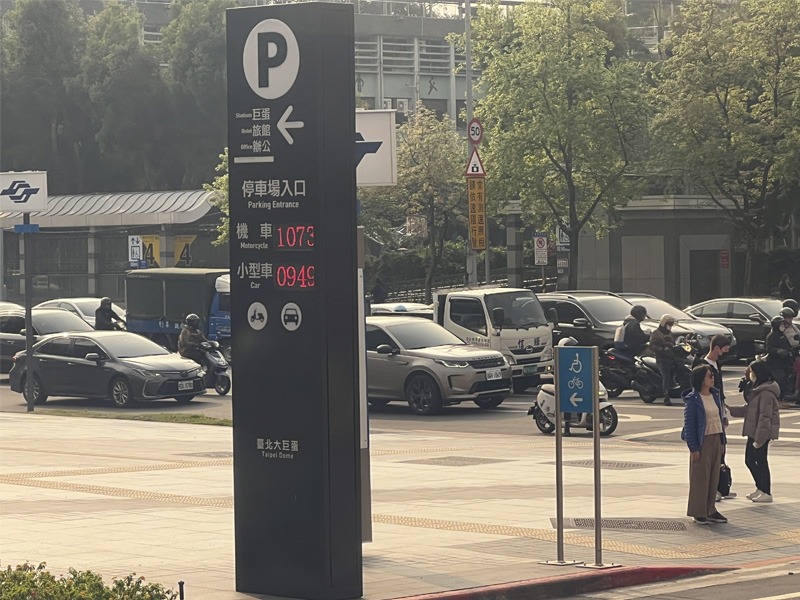
Motor Vehicles
This is where the European influence stops and the North American influence takes over… in a country where baseball is the biggest sport. With all of the active and public transport infrastructure I’ve described above, you might think that there’s little desire or space for private cars in crowded Taipei, but you’d be wrong!
There are several motorways that slice through the city – usually raised on pylons, built above a local ground level road. In some sectors they are so close to the buildings on either side that it feels like you can just about grab the washing off the balcony of the third or fourth floor apartment that you’re passing.
When I first started visiting Taipei, there was no MRT line to the main Taoyuan International Airport, which at that time also had only one terminal. The motorway to the airport was often jammed. Now there’s both an MRT line, and they’re building their third huge airport terminal, having completed the second one in 2000.
They also decided to build a second motorway on the same route between the city and the airport. Given there was no spare land, it’s on bridges above the original one. Of course, thanks to induced traffic demand, there are still daily traffic jams in Taipei.
If you’re a proponent of active transport and micromobility, you would be disappointed to visit Taipei and see how much priority the city gives to private cars.
Every new public building has underground car parking and cars are parked on just about every square metre of available kerb space and forecourts. Because land is so scarce, I’ve seen 20 or more level car parks built on tiny blocks of land. They hold only a few cars per level. You don’t drive up – the cars are raised and lowered on elevators.
There are hundreds of striped pedestrian crossings. I’m not sure what the local laws say, but in practice these crossings are ignored by most motorists and you’d soon be run over if you relied on the car drivers and moped riders to stop.
Taipei is dissected by a number of very wide, straight, main roads, which typically have six lanes of car traffic. These roads encourage very high speeds and their traffic light cycles are set to very long intervals, so it’s common for pedestrians to have to wait two minutes or more until they get a walk signal. This is a clear example of prioritising motorised traffic over pedestrians.
There were even fewer electric vehicles on the road that you typically see in Australia. I noticed a few Tesla’s but no cheaper brands. There are also virtually no micro cars of any type. Most cars are full sized sedans: Mercedes, BMW, Audi and if you can’t afford those, then Toyota and Nissan appear to be the most common brands.
Conclusions
According to one rather outdated study, in 2015 the city of Taipei had a mode share of 42% cars and mopeds, 37% public transportation, 15% walking and 6% cycling. I couldn’t find more recent data or a split between cars and mopeds. Given that cars would only be about half of the ‘cars and mopeds’ total, or around 20% of the total mode share, it’s not logical that perhaps 80% of available road space is devoted to them.
My estimates, based upon my recent visit would be that moped journeys outnumber cars by a fair margin. I doubt if the bicycle mode share has grown much if any from 6%, even though the government had an official policy goal of it growing to 10% by 2020.
Thanks to its flat terrain, high density, mild climate and already excellent public transport system, Taipei has great potential to become a far more micromobility friendly city. The bottom line, as is the case with all cities, is political will.
Are the relevant elected officials prepared to reallocate car lanes, reduce parking, especially on-street parking and tame their high speed main roads? Easier steps such as electrifying their huge bike share fleet, replacing city delivery trucks with e-cargo bikes and adding e-scooters would help. But nothing is more pivotal than the allocation of public space, in particular what is currently road space for cars.
I’m sure there would be huge pushback, as there is everywhere. Only time will tell which is the greater force.

Great article Phil, thank you. Very interesting insights for an armchair traveller. I thought Taipei was a leader in reallocating space away from cars but clearly not!
Hi Phil, great article! I used to live in Taipei and my primary mode of transport was my bike. I cycle here in Melbourne also and still find Taipei a much more bicycle friendly place to be. On the big main roads, despite being 6 lanes, often the two inner lanes are reserved for cars and the outer lane for scooters which I find much less intimidating. I also find that car speeds are slower than they are here (can also confirm as I would use car share here and there).
On the note of YouBikes, this is by far the best bike share scheme I’ve witnessed. Super well maintained, respected by the community, and very convenient to use. I’m not sure if the situation has changed, but you can use EasyCard to access the bikes so it is integrated into the public transport system.
I love this city and while there’s so much to improve, they’re doing great things (and some buses are indeed electric).
Very helpful insight. Will be visiting for the first time in October.
Yes Phil
I agree with you , as I’ve been visiting Taipei within the similar timeframe that you have and have seen this city turn from a industrial smoky disorderly city to a clean modern and modern metropolis. Super friendly and helpful on every experience. It’s definitely worth to also visit the whole counrty utilising not only the mrt and the rideshare system but in combination with the fast train system as well . Simply amazing.
Thanks for the article, I was there 12 years ago and it was the scooters and small motor bikes that got my attention. I thought it would be more electrified by now. Strange.